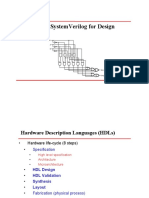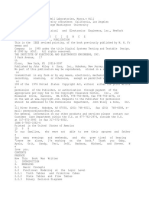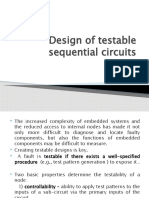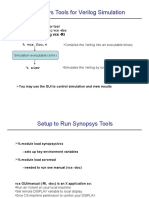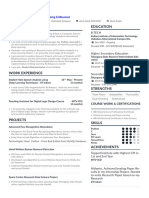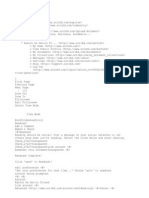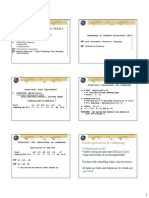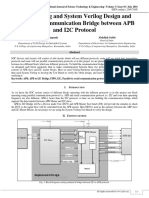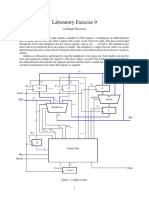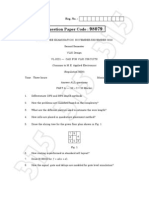0 ratings0% found this document useful (0 votes)
262 views94 pagesVlsi Prev Que Papers PDF
Uploaded by
Amit LohiyaCopyright
© © All Rights Reserved
We take content rights seriously. If you suspect this is your content, claim it here.
Available Formats
Download as PDF or read online on Scribd
0 ratings0% found this document useful (0 votes)
262 views94 pagesVlsi Prev Que Papers PDF
Uploaded by
Amit LohiyaCopyright
© © All Rights Reserved
We take content rights seriously. If you suspect this is your content, claim it here.
Available Formats
Download as PDF or read online on Scribd
You are on page 1/ 94
e
9
olf &
yl
or 0
School of Electronics Engineering, VIT Vellore
Programme: M. Tech. VLSI Design £
é Subject: Computer Aided Design for VLSI (ECES019) wt
an
' Examination: CAT1, Slot: D2 oy wee
Date: 16.08.2018, Time: 2-3.3C p.m., Total Marks: 50 wh os
the big-0 notation.
b). Determine the correctness of the following inequality f(a) = 6n°/( 1+ log n) =
O(n’)
Use the Kerighan-tin 20m
algorithm to equi-partition
the weighted graph of the
nodes A-F such that each
block contains 3 nodes.
| ae" 8 equal sized blocks C1-C8 Starting with an initial partition A =(C1-C4) and 10M
and the netlist: __ B= (C5-CB) use simulated annealing to find the
NA = (C1, C2, C4} with wi = 2 partition with the lowest cutcost. The
N2 = (C2, C4, C6, C7} with w2=2 simulacion parameters are T = 10, alpha = 0.9
NB = (C3, CB} with w3 = 1 MM = 3 and beta = 1. Terminate the simulation
(C4, C1, C3, C5} with w4=3 after T=9 and before Tless than 9,
NS = (C5, C1, C3, C7,CB} with w Use the following set of random numbers and
(C6, C5, C7} with w6 =1 swapping sequences:
(C7,C1, C3, C5, CB} with wi L077, (C1,C5)
(C8, C6, C7} with ws 0.381, (C2, CB)
0.546, (C5,C7)
0.563, (C2, C3}
0.95, (C3, C7)
0.972, (C6, C8)
8 Given thescngHoorpian
determine the sequence pair
tom
st
w
un .
&
y?
ead
@
i dead)
@ ea
@
a
a
a3
as
School of Electronics Engineering, VIT Vellore
Programme: M. Tech. VLSI Design
Subject: Computer Aided Design for VLSI (ECES019)
FS 2018-19: CAT1 Examination, Slot: D1
Date: 16.08.2018, Time: 9.30-11.00 a.m., Total Marks: 50
Given the cartesian points a(2,4), (4,2), c (3,3) and dl5,2). Draw: i) a rectilinear 10m
Prana Wee (8ST) andi) a rectilinear Steiner tree, Are the trees minimum spanning
trees? '
Use the Kernighan-Lin algorithm to equi-
Partition the weighted graph of the nodes A-F
such that each block contains 3 nodes,
n 3 20M
L
20
10,
4,
“ah
ca
veal
20
v
ze
oO
6
ee
ores vw
fire ice
sccm:
mene
eee
ae ;
Vertical Constraint Graph (vec). | A
iFten blocks C-Cip are to be equi-parttioned then determine the total number of 10m
ways in which the blocks can be partitioned. Express in the big-O notation the order
Of the computational complexity What i the cass ofthe problem of finding the
Partition with the lowest cut-cost? What generic class of algorithms can be used to
find the partition with the lowest cost?
F-2U- dH}. 2G 5
3-9 -deh 24)
Ser tnwro 2 why
wr FOO (844
(OVS tae 2a BE
be
Ws-s=4 Xo'N9
B- 8-1-0 7%
9 *b-1- € 9G
Oi= B-Fet ens EG
bay Gry s 2G
v- 2-6-1 > 3G
h- 2 9" Geter 2%
e FBG 22g
oi 7 O1- 0 2 ag
We sad - FeV ag
tis(ayp- Fen 7 wh
beer een 7G)
School of Electronics Engineering, VIT Vellore
Programme: M. Tech. VLSI Design
Subject: Computer Aided Design for VLSI (ECES019)
Examination: CAT2, Slot: D2
Date: 26.09.2018, Time: 9.30-11.00 p.m., Total Marks: 50
Quadratic Placement 15
Given:l) A placement with three fixed points p1(75, 200) p2(100,0) and p3(250, 350)
and 2) Three fixed blocks a,b,c and 3) the nets Ni, N2, N3 and N4 such that N1(P1,3,b),
N2(P2,b,c), N3(a, b,c), and N&(c,P3). Use quaaratic placement to find the co-ordinates,
of the blocks a,b,andc. Assume all the nets have weight unity,
te te Dikstras Algorithm tofnd the minimum cost path rom the source node S-k 20a?
tothe target node T= 0. ‘J
S p61) @m (a2 62)
C'S” @” @
(2.2) (42) (13,16) (8.2) Ee
Leh) 2 Oj Gwinn
(3.6) (3,8)
ee” ee oo
(20,13) (a (0243) @5)
: 2
2 138g (2 5 (2.2) @ 2en Qe te
aw) 25) (ea) (2)
ee” @ és) (43) @
Left-Edge Algorithm a5
Given achanne! with the fotowing pin connection (om et to eght)
TOP=14000£0C00€ scoo|and BOTTOM -[9F DADE ODE0000G—)
A1_Find Sol For coldmns 2-0 and the minimum numberof routing ace
DY Draw the HCG and veG
1 Use the left edge algorithm to route ths channel, Draw the channel withthe
fully routed nets
Final Assessment Test - November 2018
Course: ECE5019 Computer Aided Design for Vist
Class NBR(s):1169
Time: Three Hours
Slot: 014101
Max. Marks: 100
General Instructions : Graph Sheet to be provided
‘Answer ALL Questions
. (100 Marks)
[20]
‘The weight of the edges are as follows: AB=1, AC=3, AH=6,
CG=1, CH=5,
BH=2, Bl=1, CF=6,
Fist, Fei
DE=2, Di
Gle1, Hi=3
and U=4
Given the floorplan below generate: the slicing tree, the polish expression and the sequence pair; <*> [10]
and ,
8 c
A
D E
F
6 H
Page 1 of 2
Given three blacks a, b, ¢ along with their size options (width x height): a(1x3) and a(3xt); b(2x4) and
(4x2) and ; c(1x4) and c{4x1). Determine;
a) the shape functions for each blocks a, b,c
b) the minimum area of the top-level floorplan using the Polish expression acVbH
©). the shape function of the top-level floorplan
Given:1) A placement with three fixed points p1(50, 250) p2(150,0) and p3(250, 300) and 2) Three fixed
blocks a,b,c and 3) the nets N1, N2, N3 and N4 such that N1(P1-a,P1-b), N2(P2-b,P2-c, b-c), N3{a- b- c),
and N4(c-P3). Where Ni(P1-a, P1-b)
block b, The weights of the nets are: W(N1) = 2, W(N2)= 1, W(N3)= 4, W(N4) = 3. Use quadratic placement
\dicates that the net N1 has connections: P1 to block a and P1 to
to find the co-ordinates of the blocks a, b and c.
Use the greedy channel router algorithm of Rivest and Fidducia, to route the channel:
TOP = (54030214030 10203001}, Bottom = {0143 0.80505020403120}. Where 0
indicates no connection.
Given the nets on each side of a switch box,
(ordered left-to-right) BOT = {H B B H G00}, TOP = {CCEHF DO}
(ordered bottom-to-top) LEFT = (BH ACEC}, RIGHT=( AOD FG 0}
Route the switchbox using the Luk’s moc
cation of the greedy channel algorithm of Rivest and Fiduca.
For each column, mark the routed nets and their corresponding tracks. Draw the switchbox with all the
nets.
Given the following locations of a clock source SO and eight sinks S1-S8:
$0 (7,1), $1(2,2), $2(4,2), $3 (2,12), S4(4,12), $5(8,8), S6(8,6), $7(14,8), $8(14,6)
a) Draw the clock tree generated by MMM
b) Draw the clock tree topology generated by MMM
¢) Calculate the total wirelength (in terms of
units) and the clock skew using the linear delay
model.
{as}
[15]
(15)
{15}
[10]
Page 2 of 2
an
a2
as
School of Electronics Engineering, VIT Vellore
Programme: M. Tech. VLSI Design
Subject: Computer Aided Design for VLSI (ECE5019)
FS 2018-19: CAT1 Examination, Slot: 01
Date: 26.09.2018, Time: 2.00-3.30 p.m., Total Marks: 50
Linear Ordering Algorithm:
For the netlist with five blocks a-e and six weighted nets N1-N6, determine the linear
ordering that minimizes the total wirelength. Let the starting block bec, Place the block g
C first in the left most position. Draw the resulting placement. The nets are:
Na(a,b)=2, N2(a,e)=4, N3(a,b,c}=3, NAla,d)=5, N5(b,,e)=4 and N6(dhe)=3 ae
Note: The nets are weighted. Place the block c first in the leftmost position,
Given a placement of blocks on 2
chip as shown below. Find a
Hamiltonian Path through the
blocks and then route the power
and ground networks.
GND
Given the pin points p1(0,3), p212,3) 0314.7), paTB), 95190), BB{O), BITS.) and,
98(0.5). Construct a heuristic Steiner minimum tre using the sequential tejner Tree
Heuristic.
TOP=[00.CD BB AO] and BOTTOM =D D0C COB Al
al Find S{col) for columns a-h and the minimum number of routing tracks.
b) Draw the HCG and VCS
Ps
Use the dogleg left edge algorithm to route this channel. Draw the channel with the
fully routed nets. Gu» BS
~ TL
be ot)
@
?a
4,
Dogleg Left-Edge Algorithm fey ®
Given a channel with the Flowing pin connection (fom eftoright) APE
Ps
is
Final Assessment Test - November 2018
Course: ECES019 ~ Computer Aided Design for VLSI
Class NBR(s):1170 Slot: D2#TD2
Time: Three Hours Max. Marks: 100
General Instructions : Graph Sheet to be provided
‘Answer ALL Questions
(100 Marks)
‘The weight of the edges are as follows: AB=1, AC=3, AH=6, ‘Al=4, BD=4, BF=3, BG.
CG=1, CHS, Cl=3, DE=2, DG=3, Dis
sa
, BH=2, Bi=1, CF=6,
EG=4, EH=6, El=9, FG=3, FH=2, Fi=1, Fl=2, Gla
2. Given a placement of blocks on a chip as shown below. Find a Hamiltonian Path through the blocks and xg}
then route the power and ground networks.
'e leftmost position. Draw the resulting
placement. The nets are: N1{4-b,e), Need), N3BCA.N, NA (3460), NS (cf), NEla,b,,d,e,), The weights
of the nets are W(N4) = 2, W(N2) = 3, ‘W(N3) = 1, W(NA) = 1, WINS) =
and, W(N6) = 5
Page 1of2
4,
Given a channel with the following pin connections (from left to right)
oe stettcc 5 20550640] and BOT =[2036420100464035060205)
Ro}
Find S(col) for columns a-v and the minimum number of routing tracks.
b) Draw the HCG and VCG
Use the dogleg left edge algorithm to route this channel. Draw the channel with the fully routed nets.
Given the nets on each side of a switch box, [15]
(ordered left-to-right) BOT = {0D G F AO}, TOP = {D BEC AO}
{ordered top-to-bottom) LEFT = {0 G E C D0}, RIGHT=(0 B FAG 0}
Route the switchbox using the Luk’s modification of the greedy channel routing algorithm of Rivest and
Fidducia. For each column, mark the routed nets and their corresponding tracks. Draw the final switchbox
with all the routed nets.
‘Given the following locations of a clock source S» and eight sinks Sy
[20]
a) Draw the clock tree generated by RGM. Use the linear delay model when constructing tapping points.
Let each sink have no delay, ie. ti(5)=0, where 1 <=i <= 8
b) Draw the clock tree topology generated by RGM
©) Calculate the total wirelength (in terms of grid units) and the clock skew using the linear delay model.
$0 (7,1), $1(2,2), $2(4,2), $3 (2,12), $4(4,12), $5(8,8), 56(8,6), $7(14,8), $8(14,6)
eee
giabus
Page 2 of 2
Final Assessment Test - November 2018
Course: ECESO17 Digital Design with FPGA
Class NBR(s):1154 Slot: F2,
Time: Three Hours Max. Marks: 100
PART ~ A (10X 5 = 50 Marks)
Answer any TEN Questions
*ssignment were used? Compare it with the seme code in a combinatorial block,
3. Draw the hardware logic that get infers for the following code
module example (clk,CS,NS);
input clk;
input [3:0] cs;
output [3:0] Ns;
reg [3:0] NS;
plays @ (clk or Cs)
begin
integer temp;
if (clk)
tempe cS;
NS=temp;
end
endmodule
4. Write behavioral Verilog code for 2:4 decoder circuit using for loop.
5. Consider the data p= 4’b000x q
a) yR&s;
b) y= ree
ao yepta
d) y=ras;
©) ¥= (263},2{r),2’b19}
& Define half-adder and fulladder as function and write behavioural Verilog code for 64-bit adder using them.
"b2112 r= "60101 s= 4'b1100, Obtain the output for the following.
7. Using the following input wave form for input a, plot the different wave forms generated from the following
statements. Explain the differences, Why are there so many ‘ways to describe a circuit?
The statements:
ot #2 (b, a};
assign #2
always @(a)
#2b=
always @(a)
b= #2~a;
Page 1 of 4
10.
1.
12.
13.
snows et ©
#2b
always @(a)
be= #2"a;
=
a 8 12 16 20
time
Write behavioral verilog code to count the number of occurrence of prime number from 1 to 1000, Use only
ifelse construct.
Design an FSM state graph that has an input w and an output z. The machine is @ sequence detector that
produces z=1 when the previous two values of w were Oi or 10; otherwise 2-0. Write verlog code by
considering FSM coding guidelines.
Draw the FPGA Generic Architecture and brief about each component.
Do the two code fragments below do the same, thing? If not, how do they differ? _
// Fragment A. S7 5 es
if(foo>bar)x=x+1;elsey=y+t; Ye | wed uel
1/ Fragment B. °
case ( foo > bar) - c
Axexth ¢
default:
endease
a
SI
t
u
yeh Act
Write a User Defined Primitive definition to realize the output logic of S-R Flip Flop. Consider rsing edge clock
and clear.
PART ~ B (5 X 10 = 50 Marks)
‘Answer any FIVE Questions
Draw the state graph, state table and wr
verilog code to design the control circuit shown in Fig.1 using
FSM coding guidelines. Also write the test bench to verify the functionality of the same. The following are
the operation to be performed by the control circuit.
‘The contents of R2. are first loaded into R3, using the contro! signals R2out =1 and R3in=1. Then the
contents of Ri are transferred to R2, using control signals Rlout=1 and R2in=1. Finally the contents of R3
(which are the previous contents of R2) ae transferred into R1, using RZout=1 and Riin=1, Since this step
completes the required swap, we will indicate that the task is completed by setting the signal Done=1-
‘Assume that the swapping is performed in response to a pulse on an input signal called w, which has
duration of one clock cycle.
Page 2 of 4
14.
15.
w | __,. tout
[> ran
Control Circuit [-——> aout
dock >} nummer con
[> aout
[— ain
Fig.
A tachometer measures rotation rate by detecting marks on a disk using photo detectors as illustrated
below. In the illustration there are two rings of marks, in this only the outer ring (the one with lots of
marks) will be used. As the disk spins the number of marks passing under the disk is counted. At fixed
intervals a rotation rate is updated. Write Verilog behavioral description for hardware that determines
the rotation rate using the photo detector output and also the test bench. The module has the following
declaration:
module tach1(rpx,pd,clk);
input pd, clk;
output rpx;,
wire pd, clk;
reg [9:0] rpx;
parameter freq = 500;
parameter marks = 4;
Parameter update_interval = 0.5;
parameter perwhat = 60;
'nput clk is a square wave for use by the module. Input pd is the photodetector output. itis 1 when a
mark is under the photodetector. Output rpx is the rotation rate. Parameter freq is the frequency of clk
and marks is the number of marks on a disk. Parameter update_interval is the number of seconds
between updates of rpx. For example, if update_interval were 3 then rpx would have to be updated
every 3 seconds. Parameter perwhat is the time unit for measuring revolutions, in seconds. If itis 60 then
‘Px should be in revolutions per minute, if itis 1 then rpx should be in revolutions per second, etc. Follow
the rules when writing the hardware description, (The rules do not apply to test bench code.)
© Do not use multipliers or dividers.
© Donotuse delays: #3
You can use event controls: @ (posedge clk)
‘Write Structural level Verilog code for the circuit shown in Fig.2. Also write the test bench such that it
display the output whenever there is a change in the output.
Page 3 of 4
en
add_sub
|. p
Parity Checker
Fig.2
16. Draw the state graph and state table to identify the overlapping sequence 11001. Write behavioural
verilog code by adhering FSM coding guidelines. Also write the test bench to generate the inputs and
display the output whenever there is a change in the output.
17, Write Verilog code to generate multiphase clock signal as shown in Fig.3 using the circuit shown in Fig. 4
using the following,
a. Using behavioral level description
b. Using task definition
te AAPL
Fig.4
18. Draw the architecture of Cyclone IV FPGA and explain it’s modes of operation.
eee
Page 4 of 4
Vi
Vellore Institute of Technology @
SCHOOL OF ELECTRONICS ENGINEERING
Continuous Assessment Test - I
Course: Digital Design with FPGA. Course Code: ECES017
Max. Marks: 50 Max. Time: 90 Min
Branch: M.Tech, VLSI Design Slot: FL
_AC List out the syntax errors in the following verilog code 5] >
module 12mux (1.3.9);
input [1:0] 1; fl
ouput ys] Spebbiny wn
Cee! spiny whe
assign Y= (~s & I[0]) | (S & I[1]):
endmodule;
26 We are often sloppy with the term wire in verilog. Actually verilog has several types of [10]
nets, wor, wand and wite is one of them. You can actually do logic on certain types of 3
| nets. Write a description of a half adder that only uses buffers and invertors these are gate +
primitives and do all ofthe logic on the nets. Use the module header below.
module wired Add(output sum, carryout, input A, B);
Seo > warileg tuk dow Hhak °
myo Tire the eae Tor half adder as a de above using wand and wor.
b. Change all net types to “wire” but keep everything else the same.
c. Explain the difference between part a and b.
_D~ 4 losie circuit which has two control inputs and two data inputs. The system performs [10]
addition when control input is 0, subtraction when control input is 1, 1's complement of
inputs when control input is 2 and 2°s complement of inputs when control input is 3.
Design the logic circuit and write data flow level Verilog code.
0
Page 1
4, Write Structural level Verilog for the following logic circuit (15)
Halt Halt
Subtractor Subtractor
s Parity
4 Maltiplexer Checker
4
v
Xoe
5. For each of the parts below write verilog code that implement the functionality shown in [10]
the schematic. Your verilog code just has to produce the same values for its outputs ~ it
doesn’t have to replicate the schematic logic gate-for-gate. Be sure to include the
appropriate declarations for any wires used in your code.
a. Accircuit that tests an 8-bit value to see if it’s zero.
b. A logic function implemented as a multiplexer-based lookup table.
a8 (ey
| 00 eps shure trv code
oO
wo [77 Zot an | Ax (om) > Lone Sebirtien
"
(AB)
Se Page 2.
SCHOOL OF ELECTRONICS ENGINEERING
CONTINUOUS ASSESMENT TEST - I
Course: Digital Design with FPGA Course Code: ECE S017
Max. Marks: 50
Branch: M.Tech (VLSI Design)
1. Fill in the table showing the values for the four registers at the given times. Legal (51
answers are 0, 1, x, z, and indeterminate.
<= #1 1°60;
qa Pol;
‘bL;
wait (
"00;
"60;
a HOT;
end
Signal | Value at the end of time 0_| Value at the end of time 1
4 o eS
—_ jndates. ry) 4
s Fncdet oO
tt FA
module assgQ;
reg [15:0] a, bs
initial
List the changes (values and times) to a and b in the module below.
t:0 arly be
tea ar 2 bs
bee asl
£23 as it
b&b dbo Ee RPO
4 3;
bad
bem
b= #0 6;
ba;
#20;
end
endmodule
Write behavioral verilog description for full subtractor by using function call for 15]
obtaining it’s outputs
Write behavioral Verilog code to count the sequence 0001, 0010, 0100, 1000, 0001, {10}
0010, 0100..... use if-else construct only to realize the logic. Also write test bench to
generate clock with duty cycle of 10 tu and display the output in decimal form.
Re-write the module in behavioral form. The delays can be assumed to be inertial [10]
delays.
module expl_str(x,y,4b,0);
input a, b, ¢;
output x, y3
wire a, b, 6X, ¥F
wire na, nb, nc, 13, 15, 16;
not nI (naa);
not n2(nb,b);
not n3(nc,e);
and #1 al (t3,na,b,0)3
and a2(S,a,nb,0);
and a3(t6,a,bne);
or o1(x3,16);
or #3 02(7,a,15)5
endmodule
Write Verilog behavioral description so that it operates as follows. 5}
Compute 32-bit output eq_time so that itis the number of consecutive positive edges
of input elk for which 32-bit inputs siga and sig remain equal. The counting should
start on the first positive edge of elk after siga becomes equal to sigh; the count starts
at zero at the moment they become equal, and while they remain equal the count is
incremented at each positive edge. The count should go back to zero at the first
positive edge of elk after siga becomes unequal to sigh.The count goes to zero even if
siga and sigh become equal again before the posit
ive edge. Write the test bench to
verify the same.
= Page 2 ——_____—
@
Final Assessment Test - November 2018
(y VAT course: eceso17 —~ igitat Design with rP0a
3
WoreinsiateoTecknaieg Class NBR(s): 1153 Slot: F1
a Time: Three Hours Max, Marks: 100
PART ~ A (10 X 5 = 50 Marks)
Answer any TEN Questions
Explain the port connection rules and data type deciaration with the help of an example.
Why a blocking assignment should be used for combinational logic and what would happen if @ non-blo.
assignment were used? Compare it with the same code in a sequential block.
Draw the hardware logic that will infer for the following code.
‘module multiphase (clk,A,B,C,E};
input clk,A,B,C;
output E;
regeE,0;
always @ (posedge clk)
Eee D1G
always @ (negedge clk)
D<= A&B;
endmodule
Write behavioural Verilog code for shift register with following specifications.
Shift Load Register Operation
0 0 No Change
0 1 Load Parallel Data
1 X (don’t care) | shift Right
Consider the input a=4'b0010; b=4’b1011; c=4’bixd; d= 410d;
Write the output for the following?
yr ace2;
yeallc;
©
yea nb;
¥= {2{a},3{d},101);
y= {a,c,d};
ye cR&e;
Define divide by 2 counter and divide by 4 counter as task and write behavioural verilog code to divide the
given clock by 2 and 4.
Page 1 of 4
10.
1.
&
@
Using the following input wave form shown in Figure 2 for input b, plot the different wave forms generated
from the following statements. Explain the differences. Why are there so many ways to describe a circuit?
The statements:
not #2 (a, b);
assign #2 a=“b;
always @(b)
#a=b;
always @(b)
a=#2~b;
always @(b)
f2a
Fig.
Explain about 1/0 Structure of generic FPGA device.
Design an FSM state graph that has an input w and an output 2. The machine is a sequence detector that
produces 2=1 when the previous two values of w were 00 or 11; otherwise 2=0. Write verilog code by
considering FSM coding guidelines.
Write behavioral verilog code to count the number of zero’s in the incoming serial data. Use only if-else
construct.
Explain how each of the three statements below behaves differently with unknown values. In particular,
explain what has to be unknown and how the results of each statement are different.
Statement:1
mi=a>b?c:d;
Statement:2
if(a>b)m2=
Statement:3
; else m2 = dj
case(a>b)
1:m3=c;
default: m3 = d;
endcase
Write a User Defined Primitive defini
clock and clear for the logic.
ion to realize the output logic of J-K Flip Flop. Consider rising edge of
Page 20f4
PART~B (5 X 10 = 50 Marks)
Answer any FIVE Questions
13. A sequence generator is to have four binary output designated W, X, Y, Z. They have to follow cither of
tg seayenes depending onthe vale of Belean arable I, the Sequence tobe follows 00
1100,0160,0110,0010,0611,6001,1081,1000.
tf,
yo Sg
the sequence to be followed is 1001,0001,0011,0110,0100,1100,1000,1001.
Where W is the MSB and Z is the LSB, Draw the state graph, transit
Write behavioral verilog code for the same.
n table and design using Jk Flip Flop.
14. Write behavioural verilog description and test bench of a FIFO-like module which has a 3-bit data input,
in; a 7-bit output, out; 1-bit inputs inclk and outelk; and 1-bit outputs full and empty. The module
operates like a FIFO (first in, first out) except that the width of the data input and output ports are
different. It reads data 3 bits at a time (on a positive edge of inclk) and outputs 7 bits at a time (consisting
of data from two input words plus one bit of a third). Unless the module has less than 3 bits of space left,
on a positive edge of inclk the value on in is stored. The oldest 7 bits stored by the module always appear
on output out. On a positive edge of outelk the oldest 7 bits are removed and the output displays the next.
7 bits. Output full is 1 if the module cannot accept another 3 bits of input and is 0 otherwise; output
empty is 1 if the module is empty and is 0 otherwise. Use parameter storage for the total number of bits
stored by the module.
‘An example of the module operating is shown in the timing diagram of fig.2 below.
inet Le LPI
in oot — 610 ort Hoo tor fx — 1 fo00 ~~ joo 010 —font 00
out | 1 lama —
cit = oss joras yrorono1 forgo “ietttior | pos
‘a _ A m
empty =
eee eee tribe r ee tee ei ba
Q 10 2
Fig.2
15. Write Structural level Verilog code for the circuit shown in Figure 3. Also write test bench such that it
display the output whenever there is a change in the output.
mo noe no Jo te
Page 3 of 4
oO
16. Draw the state graph and state table to identify the overlapping sequence 10101, Write behavioural
Verilog code by adhering FSM coding guidelines. Also write test bench to generate the inputs and display
the output whenever there is a change in the output.
17. Write Verilog code for n-Bit universal shift register shown in Fig.4 using generate Loop statement. Also
write test bench such that it display the output whenever there is a change in the output.
sion 3} ena tt x) ten in
ssc ‘ral
wo eo
a ee AT it
ipa ipa Up Lp ay
ea ant ae] | [Tene
vet | E f Y
ont) sou Ll
Parallel data input
Right shift i ll i A Left shift
serial input serial input
reset —pdcue 2 © BA ste — spode
control
otk PK Oy On Op Sf
Wt
Parallel data output
Fig.4
18. Draw thé architecture of Cyclone Il FPGA and explain the different modes of operation.
od
Page 4 of
\
a Final Assessment Test - November 2018
ve V I I Course: ECE5017 Digital Design with FPGA
* Winginti theming Class NBR(s):1254 Slot: F2
= Time: Three Hours Max. Marks: 100
PART —A (10 X 5 = 50 Marks)
‘Answer any TEN Questions
Can | use multiple assign statements targeting the same wire? Justify your answer with an example.
Why a nonblocking assignment should be used for sequential logic and what would happen if a blocking
assignment were used? Compare it with the same code in a combinatorial block.
Draw the hardware logic that get infers for the following code
module example (lk,CS,NS};
input clk;
input [3:0] cS;
‘output [3:0] NS;
reg [3:0] NS;
always @ (clk or CS)
begin
integer temp;
if (clk)
temp= CS;
Ns=temp;
end
endmodule
a Write behavioral Verilog code for 2:4 decoder circuit using for loop.
9 Consider ‘the data p= 4’b000x q= 4’bz11z r= 4’b0101 s= 4’b1100. Obtain the output for the following.
a) y= &s;
b) ys reed
od yepta
d) y=r4s;
e) y= {2{s},2(r},2’b10}
@ Define half-adder and full adder as function and write beha
ural Verilog code for 64-bit adder using them.
Using the following input wave form for input a, plot the different wave forms generated from the following
statements. Explain the differences. Why are there so many ways to describe a circuit?
The statements:
not #2 (b, a);
assign #2 b= ~a;
always @(a)
#b="a;
always @(a)
Wa;
Page lof 4
You might also like
- VLSI and Chip Design - Table of ContentsNo ratings yetVLSI and Chip Design - Table of Contents4 pages
- Synopsys Tools For Verilog Simulation: Run GUI by Using Vcs - RINo ratings yetSynopsys Tools For Verilog Simulation: Run GUI by Using Vcs - RI19 pages
- Verification of Digital Systems: Unit 1: Introduction Part 1No ratings yetVerification of Digital Systems: Unit 1: Introduction Part 136 pages
- 1.IJECE-UVM Based Verification of Dual Port SRAM by Implementing BISTNo ratings yet1.IJECE-UVM Based Verification of Dual Port SRAM by Implementing BIST8 pages
- Image Processing To Manipulate RGB Values Using Verilog.No ratings yetImage Processing To Manipulate RGB Values Using Verilog.5 pages
- Logic BIST Test Response Compaction: VLSI Testing and TestabilityNo ratings yetLogic BIST Test Response Compaction: VLSI Testing and Testability36 pages
- Distributed Arithmetic: Implementations and Applications: A TutorialNo ratings yetDistributed Arithmetic: Implementations and Applications: A Tutorial30 pages
- Fault Equivalent & Collapsing: Combinational CircuitsNo ratings yetFault Equivalent & Collapsing: Combinational Circuits5 pages
- Unit 1: Computer Evolution Performance Measurement and ArithmeticNo ratings yetUnit 1: Computer Evolution Performance Measurement and Arithmetic131 pages
- Using Verilog and System Verilog Design and Verify The Communication Bridge Between APB and I2C ProtocolNo ratings yetUsing Verilog and System Verilog Design and Verify The Communication Bridge Between APB and I2C Protocol3 pages
- EE4415 Integrated Digital Design: Lab (Optional) : Simulation Using VCSNo ratings yetEE4415 Integrated Digital Design: Lab (Optional) : Simulation Using VCS17 pages
- Laboratory Exercise 9: A Simple ProcessorNo ratings yetLaboratory Exercise 9: A Simple Processor8 pages
- EEC 605 VLSI CAD Final Exam 1436-1437 Term 1 Cairo UniversityNo ratings yetEEC 605 VLSI CAD Final Exam 1436-1437 Term 1 Cairo University3 pages
- CSE 242A Integrated Circuit Layout Automation: Lecture: Floorplanning Winter 2009 Chung-Kuan ChengNo ratings yetCSE 242A Integrated Circuit Layout Automation: Lecture: Floorplanning Winter 2009 Chung-Kuan Cheng34 pages


